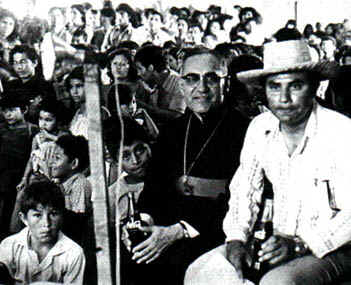|
Óscar Arnulfo Romero seemed like a holy man -- including his very real danger of martyrdom. Now the Roman Catholic Church has confirmed the late archbishop of El Salvador as a martyr, a major step toward sainthood.
I met him in Mexico in February of 1979 when I was covering a regional conference of bishops and cardinals in Puebla. My colleague Alan Riding, who was based in Mexico, knew Romero quite well, and sought him out. Standing on a street corner, they spoke and I tried to follow with my poor Spanish. My impression was of an austere man who was unafraid to speak with a reporter from The New York Times. I later learned that he spurned all luxuries back in San Salvador, insisting on a modest apartment, where he slept in a hammock, peasant-style. Archbishop Romero was associated with Liberation Theology, the concept that Christ’s teachings must be applied in an option for the poor. Romero said, “There are two theologies of liberation. One is that which sees liberation only as material liberation. The other is that of Paul VI. I am with Paul VI.” But what did the new Pope think? John Paul II, the former Karol Wojtyla of Cracow, was making his first trip out of Italy since his selection the previous fall. The world was awaiting his vision, which was delivered in the crowded Zócalo, the ancient center of the Aztec city, once named Tenochtitlan. The Pope's views can be interpreted many different ways. It sounded to me that he had suggested priests and nuns get back into uniform and stick to administering the sacraments. If so, it seemed quite likely that Oscar Arnulfo Romero had been set up as an enemy, a radical, although the cardinals tried to deny the Pope would ever be so overtly political. The Pope went back to the Vatican and the conference began in Puebla, on the other side of the twin volcanoes. I requested an interview with Archbishop Romero, and was honored when he slipped out of a conference for a few minutes. In the wintry sunshine, I asked him, as best I could, if he thought the public interpretation of the Pope’s message could be dangerous to people working with the poor in Latin America. I have lost my notes -- and the brief conversation never got into print – but the Archbishop understood my question. The danger had been ratcheted up. On March 24, 1980, I was driving in Florida and heard that Archbishop Romero had been shot once in the chest while celebrating Mass in San Salvador. Tears in my eyes, I had trouble staying on the road. That December, four American nuns were raped and killed by soldiers in El Salvador. I had met heroic nuns like that in Mexico; I think of them often. For over three decades, people have been compiling their memories of Romero – how he climbed hillsides to deliver Communion to the peasants, how he dealt with Vatican bureaucrats while watching his priests get knocked off. The current Pope, Francis I – who saw murderous activity up close in his homeland of Argentina – has encouraged the process to honor Archbishop Romero. The Pope has asked “Who am I to judge?” about gay people and is currently installing bathrooms and showers for the homeless off St. Peter’s Square. He reminds me of the cleric I met in 1979, the man with the kind, fearless eyes.
bruce
2/24/2015 03:42:14 pm
George,
Gene Palumbo
2/25/2015 06:40:45 pm
Robert White has written about how the U.S. government regarded Archbishop Romero. White, who died recently, was the U. S. ambassador to El Salvador at the time of Romero’s assassination. He was fired by Secretary of State Alexander Haig soon after President Reagan’s inauguration. He wrote,
bruce
2/26/2015 12:57:14 am
gene, Comments are closed.
|
Categories
All
|










